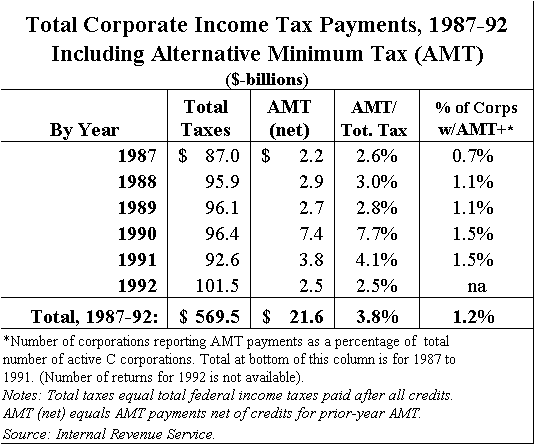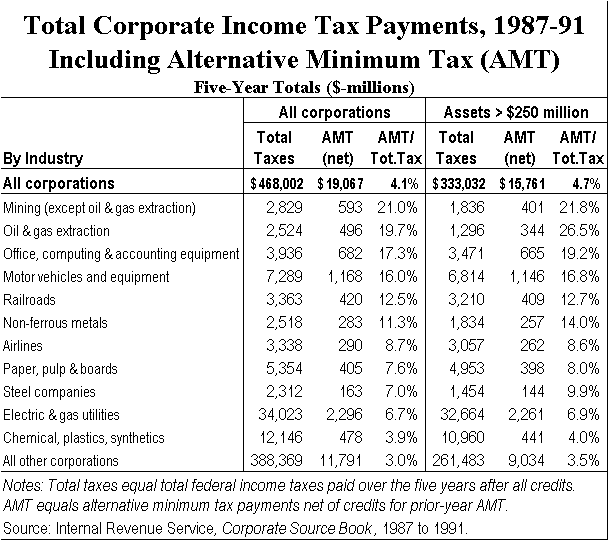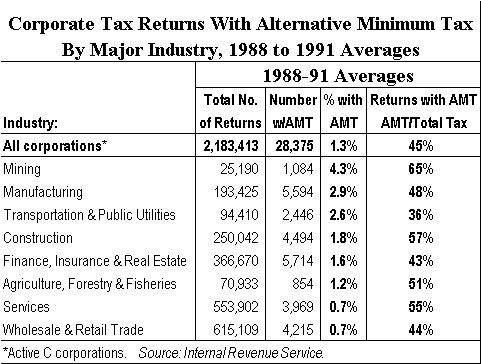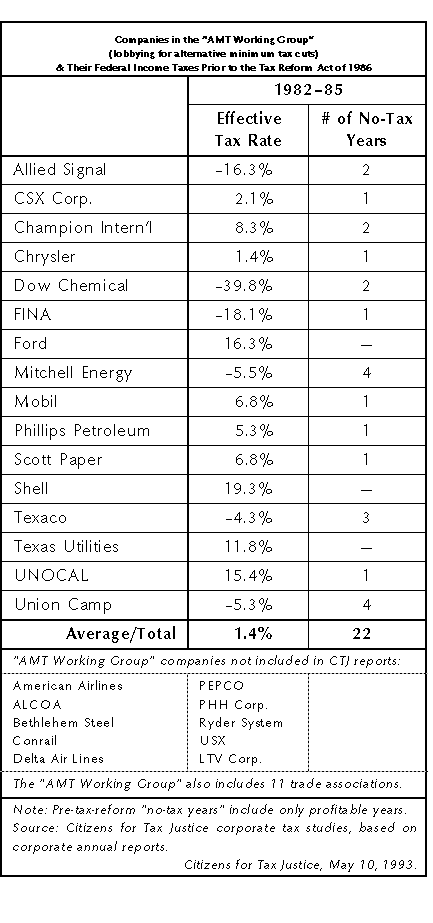March 25, 1993 04:48 PM | Permalink | 
March 25, 1993
Multinational corporations, whether American- or foreign-owned, are supposed to pay U.S. income taxes on the profits they earn in the United States. But our tax laws often fail miserably to achieve this goal. As a result, our corporate tax base has been undermined, multinational businesses gain an advantage over their purely domestic competitors and the U.S. tax system subsidizes the foreign operations of multinational firms, sometimes at the expense of American jobs.
Our present system for measuring the U.S. income of multinational businesses is fundamentally flawed, both in theory and in practice. We need to overhaul our rules governing international allocation of profits, to protect our tax base and our workers. Specifically, we should abandon the complex and unworkable so-called “arm’s length” method of allocating profits among countries (which hopelessly asks the IRS to scrutinize hundreds of millions of intra-company pricing transactions) in favor of a formula approach similar to that used by American states (and by Canadian provinces) to allocate the taxable profits of multistate corporations. The pending North American Free Trade Agreement offers us a chance to begin the long overdue move to such a system.
The Defects of the Current “Arm’s Length” System
Currently, the IRS attempts to measure how much profit a multinational corporation makes in the United States using what is variously called the “arm’s length” or “transfer pricing” or “separate accounting” system. It was established in the 1960s, when trade accounted for only about 1/20th of our gross domestic product. After a long debate, our Treasury Department settled on the arm’s length approach (as opposed to a formula system), and then sold it to our trading partners.(1) Essentially, the present system requires multinational companies to assign “transfer prices” to each real or notional transaction between their domestic and foreign affiliates. In theory, these transfer prices are to be set as if the transactions had occurred between unrelated parties on an “arm’s length” basis.
Not surprisingly, in computing their U.S. income, multinational companies try to maximize their U.S. deductions and minimize their U.S. gross receipts. The standard mode of tax avoidance entails setting transfer prices that undercharge or overpay a company’s foreign affiliates when goods and services are exchanged or shared. It should be obvious that the opportunities for abuse of this system, under which the IRS is called upon to scrutinize hundreds of millions of transfer prices, are almost endless. In a recent study mandated by Congress, the IRS reported that “a significant section 482 issue may take eight or more years to resolve.”(2)
Today, as exports and imports of goods and services have each grown to more than a tenth of our GDP, the fundamental flaws of the arm’s length system have been magnified. The U.S. experience with the arm’s length standard over the past 25 years shows that it is not well-suited to resolving competing national claims to tax revenues from multinational corporations. Indeed, the complexity and incoherence of the current system encourages multinational firms to file U.S. tax returns that can be best compared to “low-ball opening bids” in a tax-avoidance game in which the companies hold most of the cards.
Once a multinational company makes its opening tax bid, the IRS must attempt to determine–through adversarial proceedings–what are the flaws in the multitude of transfer prices the company has assigned to its international dealings. The IRS must first try to recalculate the income of each corporate entity in a chain of related foreign and domestic companies under the arm’s length standard. It then must apportion the income so determined between U.S. and foreign sources under the source rules of the Code. Through this case by case process, the United States establishes its claims to tax revenue from transnational income. Those claims may and often do conflict with the claims of other countries. Some procedures are available under U.S. tax treaties to reconcile the competing claims, but those procedures are cumbersome and can only be used for a tiny fraction of transfer pricing disputes.
The practical failure of the arm’s length standard is by now beyond dispute. For example, most foreign-based multinationals report little or no American taxable income on their U.S. tax returns, despite conducting extensive sales and manufacturing activities in the United States. These companies are able to report such low profit figures by manipulating their transfer prices. Likewise, U.S.-based multinationals frequently employ creative transfer pricing strategies to avoid the bite of the foreign credit limitation rules and to shift income to low-tax countries. The IRS can monitor only a very small fraction of the hundreds of millions of transactions governed by the arm’s length standard. Even this limited scrutiny is enough, however, to generate tax deficiencies in the billions of dollars. By the end of this decade, the Tax Court’s backlog of section 482 cases may well exceed $100 billion in disputed taxes.(3)
When Treasury adopted the arm’s length approach in the sixties, its architects recognized its complexity, but thought it would be more “accurate” than the simpler formula approach that was also considered. But the truth is that the arm’s length system is widely recognized to be theoretically, as well as practically unsound.
“Separate accounting,” wrote Professor Jerome Hellerstein in 1983, “operates in a universe of pretense; as in Alice in Wonderland, it turns reality into fancy, and then pretends it’s in the real world. For the essence of the separate accounting technique of dividing the income of a unitary business is to ignore the interdependence of the operations . . . , and treat them, instead, as if they were separate, independent and non-integrated.”(4) Similarly, former assistant Treasury secretary Charles E. McLure, Jr. has written that “separate accounting cannot satisfactorily divide income of a unitary business.”(5)
Corporate executives have been equally critical of the arm’s length system. A 1981 GAO report, for example, cites a 1980 business survey, which found that:
“Although [multinationals are] composed of numerous legally separate entities, [a majority of the executives of such firms offering an opinion] reveal that their companies make most intercompany pricing decisions as though the organization is one economic unit. This basic difference in philosophy between the IRS and multinational corporations is central to [transfer-pricing disputes].”(6)
The GAO report goes on to relate that corporate officials have called outcomes under the arm’s length system “arbitrary” and have complained that “the analytical approach to determining arm’s length prices often leads to unreasonable results.”(7) A chorus of other experts echoes these conclusions.(8)
To be sure, the temporary and proposed regulations issued under Code section 482 at the close of the Bush administration will make it easier for IRS auditors to identify major transfer-pricing abuses. Those regulations will also close some of the loopholes opened in the old regulations by the courts. They will not do very much, however, to solve the fundamental problems with the arm’s length standard. Transfer pricing disputes will not diminish in frequency or in importance. They will be settled, in the appeals process or in the courts, on obscure or arbitrary grounds that will provide little or no guidance for avoiding or settling future disputes. Some companies will continue to avoid paying any significant taxes to any government by taking inconsistent tax positions with the U.S. and foreign tax authorities. Other companies may be subject to double taxation because of inconsistent positions taken by U.S. and foreign tax authorities.
The Better Alternative: Formulary Apportionment
If the arm’s length, separate accounting system is a failure, what then is the alternative? The best way for governments to resolve their claims to tax revenues from the income of multinational enterprises is through a mechanism that allocates the worldwide income of unified business enterprises by formula among the countries in which those enterprises operate. In a well-designed formulary apportionment system, companies would not go into battle with the tax collectors of each country. They would pay only to the government entitled to the tax revenue under an internationally accepted formula.
In essence, a formula or “unitary” approach would attribute a multinational corporation’s current worldwide income among taxing jurisdictions based on some objective measures of its economic links with those jurisdictions. For example, net income might be apportioned among taxing jurisdictions according to a weighted percentage of sales, payroll, and property within those jurisdictions. This is the system used by most American states and by the Canadian provinces.
Such a formula system would eliminate much of the complexity of the present arm’s length approach. It would also implicitly end what remains of tax “deferral” on international profits, since total current worldwide income would be included in the base for applying the formula. This would not only provide additional simplification, but would also address the “runaway plant” issue that Rep. David Obey and then-Rep. Byron Dorgan tried to deal with when they introduced H.R. 2889 in 1991.
Of course, the formula method will not yield perfect results in all instances. Nor will it solve all administrative and implementation problems.(9) But the formula method will produce consistent, fair outcomes–a far cry from the current arm’s length system. As one commentator noted:
“Perhaps the underlying reason for its superiority is that the formula approach makes no claims to achieve a perfect result. It recognizes, rather, that a perfect allocation is impossible. The unitary system seeks a reasonable division of income by formula. The arm’s-length standard strives for reasonable accuracy, but it fails to achieve it and its theoretical basis is unsound.”(10)
Although a formulary system is superior to an arm’s length system both in theory and administration, it will not be easy to put into place through the unilateral actions of a single government. Most of the major countries of the world must agree to become part of the solution.(11) Reaching consensus on formulas among the states of the United States has been a protracted process that is not yet completed. But while reaching agreement among the nations of the world will not come easily or quickly, it will not come at all unless the United States takes a leadership role in promoting formulary apportionment.
A First Step: Formulary Apportionment as Part of NAFTA
As an important first step toward worldwide adoption of formulary apportionment, we suggest that the United States work with the governments of Canada and Mexico to establish a formulary apportionment system for the North American Free Trade Zone. Business enterprises operating within NAFTA countries would file consolidated returns showing the total income from those three countries. That income would be allocated among the three member states by formula. We suggest, at least tentatively, that the formula apportion about half of the income from the manufacture and sale of goods to the country of manufacture and the other half to the country of sale.(12) Alternative formulas might be used for allocating income from natural resources and income from services.
To promote formulary apportionment under NAFTA, Congress should encourage the Treasury Department to renegotiate the U.S. tax treaties with Canada and Mexico to allow the use of formulas within NAFTA. The new treaties should also establish a united set of withholding rates, so that remittances from NAFTA to the rest of the world would bear the same tax without reference to the country from which the remittance was made. This uniformity would hugely simplify business operations in NAFTA and would substantially reduce opportunities for tax avoidance and evasion. It also would help generate the understanding and good will that are essential for the long-term success of the NAFTA experiment.(13)
The use of a formulary apportionment system under NAFTA would give a major boost to worldwide adoption of a formulary apportionment system. With the disintegration of borders within the European Community, the arm’s length standard will become increasingly unworkable for allocating income among EC countries. It is likely, therefore, that the EC would watch the successful implementation of formulary apportionment in NAFTA with great interest.
Conclusion
In the 1960s, the United States government made some important, and we believe mistaken, decisions about how to allocate the taxable income of multinational corporations. Today, with international trade growing ever larger as a share of our nation’s economy, we need to rethink those decisions. The pending North American Free Trade Agreement and integration of the European Community make replacing the discredited arm’s length system with a simpler and fairer formula approach both more necessary and more likely. We hope that these hearings will help move U.S. policy in that direction.
1. The regulations under section 482 were issued in 1968 in response to an invitation by the
Conference Committee Report on the Revenue Act of 1962 to “explore the possibility of developing and promulgating regulations under [the authority of section 482] which would provide additional guidelines and formulas for the allocation of income and deductions in cases involving foreign income.” H.R. Rep. No. 2508, 87th Cong. 2d Sess. 18-19 (1962) (our emphasis).
2. “IRS Report on Application and Administration of Section 482,” presented to the House Ways and Means Oversight Subcommittee, Apr. 9, 1992.
3. In April of 1992, then Chief Tax Court Judge Arthur L. Nims III stated that his court had a backlog of section 482 cases with an amount in controversy of $32 billion and that the amount had doubled in two or three years. These figures are the tip of an iceberg; according to the IRS, about 90 percent of contested section 482 adjustments are settled at the Appeals level without going to court.
4. Hellerstein, “The Basic Operations Interdependence Requirement of a Unitary Business: A Reply to Charles E. McLure, Jr.,” Tax Notes, Feb. 28, 1983, at 726.
5. McLure, “The Basic Operational Interdependence Test of a Unitary Business: A Rejoinder,” Tax Notes, Oct. 10, 1983, at 99. The theoretical weaknesses in the arm’s length approach are explained in Michael J. McIntyre, The International Income Tax Rules of the United States (1989, 1992), chapter 5/d. For additional references to the literature, see the bibliography at the end of that treatise.
6. Burns, “How IRS applies the intercompany pricing rules of Section 482: A corporate survey,” 52 J. Tax. 308, 314 (May 1980), paraphrased in Comptroller General, IRS Could Better Protect U.S. Tax Interests in Determining the Income of Multinational Companies, Report to the Chairman, House Committee on Ways and Means (1981), at 45.
7. GAO report cited in note 6, at 44. In its most recent report on transfer-pricing issues, the GAO praised the IRS for its recent efforts to improve administration of the arm’s length standard but predicted that “problems with arm’s length pricing can be expected to continue.” General Accounting Office, International Taxation: Problems Persist in Determining Tax Effects of Intercompany Prices (1992), at 56. That report discussed formulary apportionment as a promising option to the arm’s length method; it concluded, however, that international agreement on formulas could not be achieved in the near term.
8. See, e.g. Stanley Langbein, “The Unitary Method and the Myth of Arm’s Length,” Tax Notes, Feb. 17, 1986, pp. 625-681; Richard Bird & Donald Brean, “The Interjurisdictional Allocation of Income and the Unitary Taxation Debate,” 34 Canadian Tax J. 1377 (1986). Dale W. Wickham & Charles J. Kerester, “New Directions Needed for Solution of the Transfer-Pricing Tax Puzzle,” 5 Tax Notes International 399-425 (Aug. 24, 1992). The Multistate Tax Commission has recently circulated a draft report that recommends that the United States move toward an international formulary apportionment system. See Multistate Tax Commission, “Asking Global Corporations to Pay their Fair Share of U.S. Taxes–The Formula Apportionment Income Reporting–FAIR–Option” (Draft dated Dec. 16, 1992).
9. Some of the problems that may arise in the design of a formulary apportionment system are outlined and some solutions to those problems are suggested in Michael J. McIntyre, “Design of a National Formulary Apportionment Tax System,” 1991 NTA-TIA Proceeding, 84th Annual Conference 118-124. That article also explains the many potential advantages of switching to a formulary apportionment system.
10. Harley, “International Division of the Income Tax Base of Multinational Enterprise: An Overview,” Tax Notes, Dec. 28, 1981, at 1567. Similarly, Peggy Musgrave has pointed out: “Proponents . . . [have] suggested that the arm’s-length-separate-accounting method is inherently closer to establishing the true source of profits and therefore is less arbitrary than the unitary approach. Such is far from the case. . . . The use of the unitary method as implemented by a factor formula is not perfect, but it places less of a burden on administrative resources . . . , there is less danger of base slippage and discretionary profit shifting . . . and there are fewer items which have to be audited and checked.” P. Musgrave, “The U.K Treaty Debate: Some Lessons for the Future,” Tax Notes, July 10, 1978, at 27, 28.
See also Comment, “Multinational Corporations and Income Allocation Under Section 482 of the Internal Revenue Code,” 89 Harv. L. Rev. 1202, 1228 (1976): “The unitary entity theory has certain clear advantages. Principal among these is its theoretical superiority as a means for ascertaining the true income of various MNC [multinational corporation] components.”
See also Wickham & Kerester, cited in note 8 at 406: “The current Treasury regulation [under section 482] focuses attention on the wrong question; It asks, `What price is right for intercompany transfers?’ The right question is `What portion of the combined profits or loss derived by all participating units of an enterprise from an international transaction should be geographically sourced to each of the countries claiming jurisdiction to tax part of that income.’ “
11. Contrary to the position sometimes taken by the Treasury Department, agreement on a formula among all countries is not needed. Once a critical mass is reached, the members of the formula consortium could simply omit from their formula the sales, payroll and property of nonmember states. For discussion of this so-called “throwout” rule, see McIntyre, cited in note 9, at 121.
12. The formula used by most of the states of the United States apportions about one-third of the income to the country of sale and the remaining two-thirds to the state of production. The fifty-fifty split suggested here in the text could be achieved under the typical state formula by giving double weight to sales. We believe that a fifty-fifty split between the country of production and the country of sale (determined under a destination test) would have political appeal in the NAFTA countries.
13. The draft treaty with Mexico negotiated by the Bush Administration does nothing to promote the cause of tax reform or the long-term goals of NAFTA. The Treasury seemed to have had as a major negotiating aim the reduction of Mexican withholding taxes on interest payments to U.S. banks. The proposed reduction will do nothing for the United States or Mexico. It will simply give windfall benefits to a small group of American banks.
![]()




 That’s not to say, however, that the Alternative Minimum Tax is paid by very many corporations. According to the IRS, from 1987 through 1991 the corporate AMT was paid by about 28,000 corporations a year–only 1.2 percent of all active corporate filers. By major industry, the percentage of corporations paying the AMT (in 1988-91) ranged from 4.3 percent in mining down to 0.7 percent in wholesale and retail trade.
That’s not to say, however, that the Alternative Minimum Tax is paid by very many corporations. According to the IRS, from 1987 through 1991 the corporate AMT was paid by about 28,000 corporations a year–only 1.2 percent of all active corporate filers. By major industry, the percentage of corporations paying the AMT (in 1988-91) ranged from 4.3 percent in mining down to 0.7 percent in wholesale and retail trade.

 Some companies complain that the AMT can be tough on them in bad years. For example, suppose a company “normally” makes $500 million in pretax profits, and that after various special tax write-offs, its taxable income is $250 million. Such a company would “normally” pay 35 percent of that, or $88 million, in regular taxes–a 17.5% effective tax rate that would be unlikely to trigger the alternative minimum tax. But should the company’s pretax profit temporarily fall to, say, only $250 million (due to an short-term downturn in sales), while its special tax write-offs remained constant, then its taxable income would go to zero, and the AMT would probably be triggered.
Some companies complain that the AMT can be tough on them in bad years. For example, suppose a company “normally” makes $500 million in pretax profits, and that after various special tax write-offs, its taxable income is $250 million. Such a company would “normally” pay 35 percent of that, or $88 million, in regular taxes–a 17.5% effective tax rate that would be unlikely to trigger the alternative minimum tax. But should the company’s pretax profit temporarily fall to, say, only $250 million (due to an short-term downturn in sales), while its special tax write-offs remained constant, then its taxable income would go to zero, and the AMT would probably be triggered. More recent corporate annual reports from some of the “AMT Working Group” members show the effects of the current Alternative Minimum Tax. Many of them would pay nothing at all in federal income taxes without the corporate minimum tax. For example:
More recent corporate annual reports from some of the “AMT Working Group” members show the effects of the current Alternative Minimum Tax. Many of them would pay nothing at all in federal income taxes without the corporate minimum tax. For example: